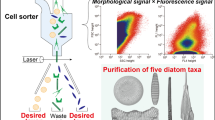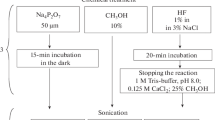Abstract
Sub-fossil diatoms represent an important archive of past environmental change in both terrestrial and marine settings. In recent years the isotopic analysis of diatom frustules has developed into an important area of paleo-environmental research. The extraction and concentration of diatoms from marine and lake sediments has proven difficult, particularly in silica rich samples. Here we present a new method for the rapid extraction of diatom frustules from lacustrine sediment using flow cytometry. This new technique produces samples suitable for geochemical and isotope-based research with a high degree of purity over a much shorter time frame than existing techniques, hours rather than days.

Similar content being viewed by others
References
Cellamare M, Rolland A, Jacquet S (2009) Flow cytometry sorting of freshwater phytoplankton. J Appl Phycol 22:87–100
Crespin J, Sylvestre F, Alexandre A, Sonzogni C, Paille`s C, Perga M-E (2010) Re-examination of the temperature-dependent relationship between δ 18Odiatoms and δ 18Olake water and implications for paleoclimate inferences. J Paleolimnol 44:547–557
Ellwood MJ, Hunter KA (1999) Determination of the Zn/Si ratio in diatom opal: a method for the separation, cleaning and dissolution of diatoms. Mar Chem 66:149–160
Fulwyler MJ (1965) Electronic separation of biological cells by volume. Science 150:910–911
Hofstraat JW, van Zeijl WJM, de Vreeze MEJ, Peeters JCH, Peperzak L, Colijn F, Rademaker TWM (1994) Phytoplankton monitoring by flow cytometry. J Plankton Res 16:1197–1224
Hurrell ER, Barker PA, Leng ML, Vane CH, Wynn P, Kendrick CP, Verschuren D, Street-Perrott FA (2011) Developing a methodology for carbon isotope analysis of lacustrine diatoms. Rapid Commun Mass Spectrom 25:1567–1574
Kalansky JF, Robinson RS, Popp BN (2011) Insights into nitrogen cycling in the western Gulf of California from the nitrogen isotopic composition of diatom-bound organic matter. Geochem Geophys Geosyst 12:Q06015, 14. doi:10.1029/2010GC003437
Lamb AL, Brewer TS, Leng MJ, Sloane HJ, Lamb HF (2007) A geochemical method for removing the effect of tephra on lake diatom oxygen isotope records. J Paleolimnol 37:499–516
Langdon PG, Holmes N, Caseldine CJ (2008) Environmental controls on modern chironomid faunas from NW Iceland and implications for reconstructing climate change. J Paleolimnol 40:273–293
Leng MJ, Barker PA (2006) A review of the oxygen isotope composition of lacustrine diatom silica for palaeoclimate reconstruction. Earth-Sci Rev 75:5–27
Leng MJ, Swann GEA (2010) Stable Isotopes from diatom silica. In: Smol JP, Stoermer EF (eds) The diatoms: applications for the environmental and earth sciences, 2nd edn. Cambridge University Press, Cambridge, pp 127–143
Leng MJ, Swann GEA, Hodson MJ, Tyler JJ, Patwardhan SV, Sloane HJ (2009) The potential use of silicon isotope composition of biogenic silica as a proxy for environmental change. Silicon 1:65–77
Mackay AW, Jones VJ, Battarbee RW (2003) Approaches to Holocene climate reconstruction using diatoms. In: Mackay AW, Battarbee RW, Birks HJB, Oldfield F (eds) Global change in the Holocene. Arnold, London, pp 294–309
Malin MA, Swann GEA (2006) Isotopes in marine sediments. In: Leng MJ (ed) Isotopes in Palaeoenvironmental research. Springer, Netherlands, pp 227–273
Morley DW, Leng MJ, Mackay AW, Sloane HJ, Rioual P, Battarbee RW (2004) Cleaning of lake sediment samples for diatom oxygen isotope analysis. J Paleolimnol 31:391–401
Phinney DA, Cucci TL (1989) Flow cytometry and phytoplankton. Cytometry 10:511–521
Schmidt M, Botz R, Stoffers P, Anders T, Bohrmann G (1997) Oxygen isotopes in marine diatoms: a comparative study of analytical techniques and new results on the isotope composition of recent marine diatoms. Geochemica et Cosmochimica Acta 61:2275–2280
Schrader HJ (1973) Proposal for a standardized method of cleaning diatom-bearing deep-sea and land-exposed marine sediment. Nova Hedwigia/Beihefte Lehre 45:400–409
Swann GEA, Leng MJ (2009) A review of diatom δ18O in palaeoceanography. Quat Sci Rev 28:384–398
Acknowledgments
Chris Caseldine, Pete Langdon, Naomi Holmes and Gareth Thompson are thanked for the use of sediment samples from Baularvallavatn. The Geography drawing office at Exeter are also thanked for their assistance in drafting the figures. Sarah Davies and Jason Jordan are thanked for their insights into diatom analysis and assistance with identification. Finally Sue Franklin, Angela Elliot, Charlotte Cook, Doris Allen and Malcolm Young are thanked for their help in the lab.
Author information
Authors and Affiliations
Corresponding author
Rights and permissions
About this article
Cite this article
Tennant, R.K., Jones, R.T., Love, J. et al. A new flow cytometry method enabling rapid purification of diatoms from silica-rich lacustrine sediments. J Paleolimnol 49, 305–309 (2013). https://doi.org/10.1007/s10933-012-9659-5
Received:
Accepted:
Published:
Issue Date:
DOI: https://doi.org/10.1007/s10933-012-9659-5




